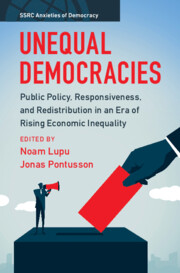Figures
2.1Coefficients for support by income on the probability of policy change (bivariate linear probability models with two-year windows)
2.2Predicted probabilities of policy change at different preference gaps between P90 and P10 or P50 (two-year windows)
2.3Policy responsiveness when the preferences of two groups align and the third group diverges (two-year windows)
2.4Predicted probabilities of policy change conditional on the P90–P50 preference gap and government partisanship (two-year windows)
2.5Predicted probabilities of policy change, economic/welfare issues only, conditional on the P90–P50 preference gap and government partisanship (two-year windows)
2.6Predicted probabilities of policy change by time period, conditional on the P90–P50 preference gap and government partisanship (two-year windows)
3.1Net transfers to M as a share of the net extended income of H and M
3.3The median net income relative to mean net income, 1985–2010
3.4Real extended income growth in 17 Europe and the United States, 1980–2019
5.1The end of state economic convergence in the United States
7.2Distribution of difference in average years of education of government and opposition members
8.4Public financing predicts modest differences in worker representation
8.6Worker representation varies more in parties than countries
9.2Alternative forms of political participation, by education and income
9.3Possible mechanisms explaining the association between unequal participation and unequal representation
9.5The power of differential satisfaction with the system in explaining differences in participation across income and education
9.6Country variation in the voting gap by income and education
10.2Fairness reasoning and demand for redistribution: unidimensional approach
10.3Fairness reasoning and demand for redistribution: two-dimensional approach
10.5Correlation between proportionality and reciprocity beliefs
11.1Posttax-and-transfer income share of the top 1 percent of individuals for nineteen advanced democracies
11.2Correlation between the annual rate of GDP growth and annual change in top-1-percent pretax income shares for a broad set of countries, before and after 1980
11.3Correlation between the annual change in the unemployment rate and annual change in top-1-percent pretax income shares for a broad set of countries, before and after 1980
11.4Association between economic news tone and pretax income growth for each income quintile, conditional on income growth for all other quintiles
11.5Association between economic news tone and pretax income growth for top-income groups, controlling for bottom- and middle-income growth
11.6Estimated coefficient ratios from models predicting economic news tone with pretax income growth for different parts of the income distribution
11.7Association between economic news tone and disposable income growth for each income quintile, conditional on income growth for all other quintiles
11.8Association between economic news tone and disposable income growth for top-income groups, controlling for bottom- and middle-income growth
11.9Estimated coefficient ratios from models predicting economic news tone with disposable income growth for different parts of the income distribution
13.1Social classes’ average predicted perceptions of systemic congruence on social policy
13.2Social class differences in proximity to preferred party and party system
13.3Social class differences in subjective proximity to preferred party and party system, by social policy area
13.4Social class differences in subjective proximity to preferred party and the party system on social consumption across different party system configurations
13.5Social class differences in subjective proximity to preferred party and the party system on social investment across different party system configurations
13.6Social class differences in subjective proximity to preferred party and the party system on benefits for migrants across different party system configurations

